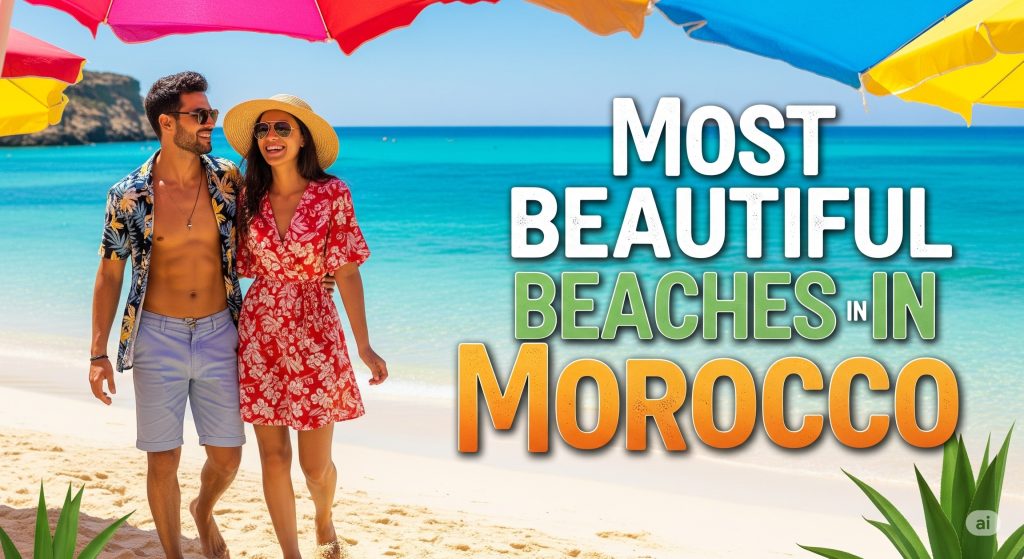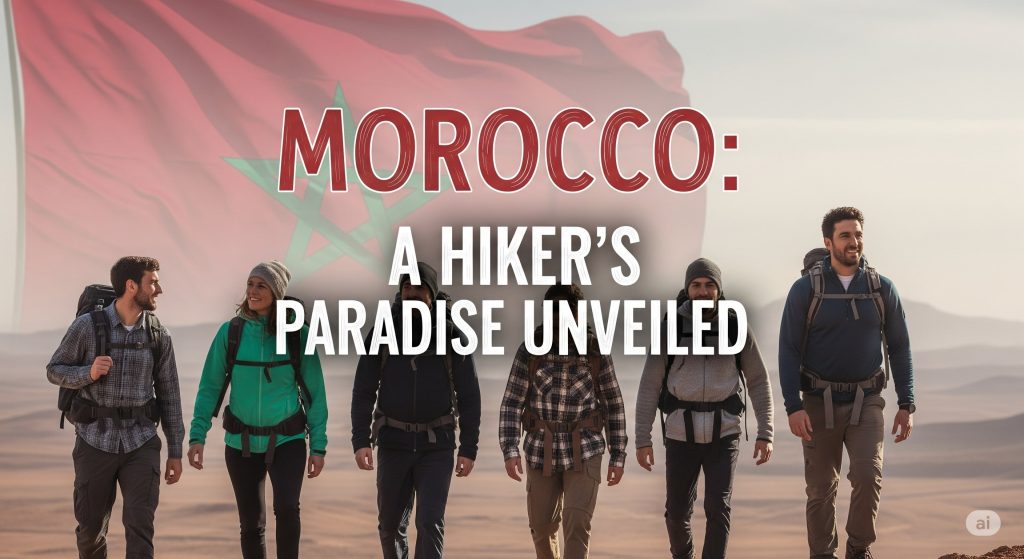Morocco, a land of mesmerizing contrasts, offers an unparalleled playground for hiking enthusiasts. From the snow-capped peaks of the High Atlas to the serene valleys of the Rif, and the vast, golden expanse of the Sahara Desert, the country’s diverse landscapes provide an abundance of trails catering to every level of experience. Beyond the breathtaking scenery, hiking in Morocco offers a profound cultural immersion, allowing trekkers to connect with ancient Berber traditions and witness a way of life that has remained largely unchanged for centuries.
The Majestic High Atlas Mountains: Crown Jewel of Moroccan Hiking
The High Atlas, known to locals as “Idraren Draren” or “Mountains of Mountains,” is arguably Morocco’s most iconic hiking destination. This majestic range, stretching diagonally across the country, is a trekker’s dream, particularly during the mild seasons of spring (March to May) and autumn (September to October).
Mount Toubkal: North Africa’s Zenith The undisputed highlight of the High Atlas is Jebel Toubkal, the highest peak in North Africa, soaring to an impressive 4,167 meters (13,670 feet). The ascent of Toubkal is a challenging yet incredibly rewarding experience, typically undertaken over two to three days. The journey often begins from the charming mountain village of Imlil, a bustling hub for hikers located a mere 90 minutes from Marrakech. From Imlil, trekkers wind their way through rugged valleys, past cascading waterfalls, and through traditional Berber villages. The first day usually involves a six-hour hike to a rustic mountain refuge, where climbers can acclimatize and share stories. The final push to the summit begins before dawn, often requiring crampons and ice axes in winter months, to witness a spectacular sunrise over a sea of peaks, with views potentially stretching all the way to the Sahara.
For those seeking a more extensive challenge, the week-long Toubkal Circuit allows for deeper exploration, traversing remote Amazigh (Berber) villages, fertile valleys, and panoramic passes. It’s crucial to note that hiring a certified local guide is compulsory for trekking in Toubkal National Park, ensuring both safety and a deeper understanding of the region’s culture and environment.
Beyond Toubkal: Diverse Atlas Adventures The High Atlas is not just about Toubkal. The M’Goun Massif, to the east, offers arguably the most classically beautiful treks, characterized by stunning gorges, lush valleys, and traditional mud-brick villages. The “Valley of Roses” in the M’Goun region, particularly vibrant in spring, offers delightful walks amidst fragrant blooms.
Further south, the volcanic Jebel Saghro range presents a dramatic contrast with its wild, open desert landscapes and isolated oases. This region is ideal for remote wilderness hiking, especially in the cooler months from December to mid-April, before water sources dwindle. The Saghro’s prehistoric feel, with its unusual rock formations, makes for a truly unique trekking experience.
The Ourika Valley, a peaceful escape just an hour from Marrakech, offers more relaxed day hikes amidst lush greenery, terraced fields, and the famous Setti Fatma waterfalls. It’s a perfect introduction to Moroccan hiking for families or those seeking a gentler pace. Similarly, the area around Imlil village itself provides numerous day-hike options, leading to other traditional Berber villages like Aremd, offering tranquil walks and panoramic mountain views.
The Serene Rif Mountains: A Northern Gem
Often overlooked by mainstream tourism, the Rif Mountains in northern Morocco are steadily gaining recognition for their untouched beauty and excellent hiking opportunities. Spring (April to June) is the prime time to explore this region, with mild temperatures and verdant landscapes.
Chefchaouen and Beyond: Waterfalls and Peaks The iconic “Blue City” of Chefchaouen serves as an excellent base for exploring the Rif. A popular and rewarding hike is the trail leading from Chefchaouen to the Akchour Waterfalls and God’s Bridge within Talassemtane National Park. This moderate trail winds through beautiful cedar forests, alongside crystal-clear rivers, and culminates in a series of stunning cascades, with the option to visit the impressive natural stone arch known as God’s Bridge.
For more challenging ascents, peaks like Mount Tissouka (2,122 meters) and Jebel Lakraa (2,159 meters, the highest in Talassemtane National Park) offer strenuous yet deeply rewarding treks with panoramic views of the blue-hued city and the surrounding rugged terrain. A local guide is highly recommended for these more demanding routes, as paths can be sparse and rocky, requiring some scrambling. The Bouhachem Regional Nature Reserve, spanning between Tetouan, Chefchaouen, and Larache, also offers a variety of trails through beautiful forests of oak and maritime pine, with opportunities for wildlife spotting.
The Endless Sands of the Sahara Desert: A Unique Trekking Experience
While different from mountain trekking, a multi-day trek through the Sahara Desert offers an utterly unique and unforgettable hiking experience. This is less about steep ascents and more about the rhythmic movement across undulating sand dunes, vast hammadas (rocky plains), and serene oases.
Camel Treks and Desert Camping Desert treks typically involve a combination of walking and camel riding, with luggage carried by camels. Popular starting points include towns like Merzouga, near the Erg Chebbi dunes, or M’hamid El Ghizlane, leading to the larger Erg Chegaga dunes. Trekkers spend nights under the vast, star-studded desert sky, often in traditional Berber camps, enjoying delicious meals prepared by camel drivers. The silence of the wilderness, punctuated only by the wind and the occasional call of a desert bird, is profoundly captivating.
These journeys offer a glimpse into the nomadic lifestyle and the ancient geological history of the region. Highlights include witnessing spectacular desert sunrises and sunsets from atop towering dunes, exploring ancient kasbahs and quranic libraries on the fringes of the desert, and encountering nomadic camps. The best time for Sahara trekking is during the cooler months, from October to April, avoiding the scorching summer heat.
The Gorges and Valleys of the Anti-Atlas and Central Morocco

Beyond the major ranges, other regions of Morocco offer incredible hiking diversity.
Todra Gorge: Vertical Cliffs and Oasis Walks The dramatic Todra Gorge, with its towering red cliffs, offers a variety of hiking opportunities. While the main gorge is easily accessible, a short distance away, trails lead into the surrounding mountains and along the lush Tinghir Oasis. The Todra Gorge Loop Trail offers stunning views, while the Tinghir Oasis & Todra Gorge Hike provides a tranquil walk through palm groves and traditional Berber villages, offering a cultural counterpoint to the dramatic cliffs. For experienced hikers, a challenging circuit connecting Todra Gorge to the Dades Valley provides a rugged adventure through remote settlements and hidden oases.
Dades Valley: Serpentine Roads and Monkey Fingers Adjacent to Todra, the Dades Valley is renowned for its stunning rock formations, especially the “Monkey Fingers,” and its serpentine road winding through the gorge. Hiking here offers diverse routes, from easy walks showcasing the unique rock formations to more strenuous treks offering panoramic views of the canyon. The Dades River, flowing through the canyon, adds a tranquil element to the landscape.
Best Time to Hike in Morocco
Morocco’s varied geography means that hiking is possible year-round, but the ideal time depends on the region:
- High Atlas & Anti-Atlas: Spring (March to May) and autumn (September to October) offer mild temperatures and vibrant scenery. Higher peaks in the High Atlas may have snow until late June, requiring winter trekking gear.
- Rif Mountains: Spring (April to June) is best, with comfortable temperatures and lush conditions.
- Sahara Desert: Cooler months from October to April are ideal, avoiding the extreme summer heat.
- Todra & Dades Gorges: Spring and autumn provide mild weather and rich colors. Summer hikes are possible but require early starts to avoid intense heat.
Essential Gear and Safety Tips
Regardless of the chosen trail, preparation is key for a safe and enjoyable hiking experience in Morocco.
Essential Gear:
- Sturdy Hiking Boots: With good ankle support and traction for varied terrain.
- Layered Clothing: The weather can change rapidly, especially in the mountains. Pack moisture-wicking base layers, an insulating mid-layer, and a waterproof outer layer.
- Sun Protection: High-SPF sunscreen, a wide-brimmed hat, sunglasses, and a light scarf to protect from sun and dust.
- Water Purification: A reusable water bottle or hydration system (at least 2-3 liters capacity) is essential, along with purification tablets or a filter, as tap water is generally not safe to drink outside major cities.
- First Aid Kit: Basic medical supplies, including blister treatment, pain relievers, and any personal medications.
- Navigation: Offline maps (e.g., Maps.me), a compass, and a guidebook are invaluable, as mobile signal can be unreliable in remote areas.
- Daypack: For carrying essentials, and a larger backpack for multi-day treks (often carried by mules).
- Cash: Smaller villages often don’t have ATMs.
Safety Tips:
- Hire a Local Guide: Especially for challenging or remote trails. They provide invaluable navigation, cultural insights, and support in emergencies.
- Acclimatize: For high-altitude treks, spend a day or two at a moderate elevation (e.g., Imlil for Toubkal) to prevent altitude sickness.
- Stay Hydrated: Dehydration is a common issue. Drink plenty of water throughout the day.
- Inform Someone: Always let your accommodation or a trusted contact know your hiking route and expected return time.
- Know Your Limits: Don’t overexert yourself. Take breaks and listen to your body.
- Check Weather Conditions: Mountain weather can be unpredictable. Be prepared for rain, snow, or sudden temperature drops.
- Respect Local Culture: Dress modestly, especially in rural areas, and always ask permission before taking photos of people.
Further read : Surf Road Trip in Morocco: Tamraght, Imsouane, and Essaouira – The Perfect One-Week Itinerary
Responsible Hiking and Cultural Immersion
Hiking in Morocco is not just about physical challenge; it’s an opportunity for deep cultural exchange. The trails often pass through traditional Berber villages, where ancient customs and hospitality are still deeply ingrained.
Leave No Trace:
- Pack out all trash, including organic waste.
- Stay on marked trails to minimize erosion and protect delicate ecosystems.
- Respect wildlife and their habitats.
- Camp in designated areas or established refuges.
Support Local Communities:
- Hire local guides and support local businesses.
- Purchase handmade crafts directly from artisans.
- Be mindful of water conservation, especially in arid regions.
- Engage respectfully with locals, learn a few basic Arabic or Berber phrases, and be open to invitations for mint tea.
Morocco’s hiking landscape is as varied as its culture, promising an unforgettable adventure for every type of outdoor enthusiast. From the iconic summits of the Atlas to the quiet serenity of desert dunes and the lush beauty of hidden valleys, the trails of Morocco offer not just a physical journey, but a profound connection with nature, history, and the enduring spirit of its people. Embrace the challenge, savor the views, and allow Morocco to unfold its wild, beautiful heart with every step.
Further read : Why Morocco Continues to Captivate Global Tourists
Planning your trip to Morocco ? Contact us now to reserve your seat


Pingback: Is Agadir Worth Visiting? 8 Reasons to Add Agadir to Your Morocco Itinerary in 2025 - Tasga
Pingback: Morocco's : Tourism Flourishes with the Africa Cup of Nations 2025